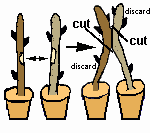From Aggie
Horticulture, Texas A&M AgriLife Extension, Texas A&M
University
System
by Larry Stein
Approach Graft
The most critical aspect of budding is cutting the bud itself-it is
only a very thin slice of bark and a sliver of wood beneath the bud,
but it must be cut evenly and smoothly. The flat side of the blade must
be flat against the budstick (Image10), with the knife held at about a
45 degree angle to the budstick. With the thumb braced along the stick
below the bud, simply draw the knife towards the thumb (again, no
sawing or rocking motion!), keeping the blade flat against the stick to
prevent it from cutting too deeply (Image The distinguishing feature of
approach grafting is that two independently growing, self-sustaining
plants are grafted together. This self-sustaining characteristic of
both plants which are to be grafted insures survival of both even if
the grafting attempt is, for some reason, not successful. However odds
of being successful are greatly enhanced because of the active growing
condition of both plants involved and absence of a time limitation
required for the healing of the graft union to occur before the
dependent scion (top portion) dies from lack of sustenance.

The approach grafting procedure is as follows:
Plant an adapted, growing plant as close to the base of the non-adapted
variety as possible without extensively damaging the root structure of
the established plant.
From both plants closely position shoots which are at least
three-eighths inch diameter and preferably close to the same size. At
the point where the union is to occur, a slice of bark one to two
inches long is peeled from both stems. The peeled area should be the
same size on each.
The two peeled surfaces are then bound tightly together with budding or
electrical tape. Wrap completely with two complete covers around the
area where the two peeled areas are in contact.
Remove some of the top portion of the foliage from the adapted variety
six to eight inches above the graft union. This will encourage a more
rapid healing of the grafted union.
The union should be complete in four weeks. This type of grafting is
most successful if performed during growth season.
After the parts are well united (4 weeks or more), the remainder of the
top of the adapted, native variety can be cut off immediately above the
graft union and the bottom or root system of the non-adapted, yellowing
plant can be cut off immediately below the graft union.
The graft union is now completed and the problems of iron chlorosis and
indigenous soil pathogens have been solved if the proper rootstock has
been used. Immediately after the portion of each plant is removed it
may be necessary to reduce the leaf area of the top if wilting occurs
because of lack of sufficient root system support. This situation will
soon stabilize. If the only problem has been micronutrient (iron
chlorosis) deficiency, the top, unadapted variety will not need to be
detached from its own root system--the approach grafted, adapted
variety root system will "feed" the sickly plant what it needs.
However, if the purpose of the graft is to control soil borne diseases,
the susceptible variety should be detached from its root system and
become totally dependent on the root system of the adapted
variety.
Publication from Aggie Horticulture®
The information, as it is presented on this Website, does not represent
an endorsement
by the State of Texas or any State agency.
Back to
Grafting Techniques Page
|
Publication from Aggie Horticulture®
|
